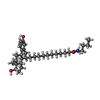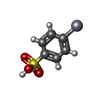[English] 日本語
 Yorodumi
Yorodumi- PDB-1hj1: RAT OESTROGEN RECEPTOR BETA LIGAND-BINDING DOMAIN IN COMPLEX WITH... -
+ Open data
Open data
- Basic information
Basic information
| Entry | Database: PDB / ID: 1hj1 | ||||||
|---|---|---|---|---|---|---|---|
| Title | RAT OESTROGEN RECEPTOR BETA LIGAND-BINDING DOMAIN IN COMPLEX WITH PURE ANTIOESTROGEN ICI164,384 | ||||||
 Components Components | OESTROGEN RECEPTOR BETA | ||||||
 Keywords Keywords | NUCLEAR RECEPTOR / TRANSCRIPTION FACTOR / OESTROGEN / ANTAGONIST | ||||||
| Function / homology |  Function and homology information Function and homology informationnegative regulation of behavior / cellular response to magnetism / response to bisphenol A / ESR-mediated signaling / response to human chorionic gonadotropin / PIP3 activates AKT signaling / amygdala development / estradiol binding / Extra-nuclear estrogen signaling / hormone-mediated apoptotic signaling pathway ...negative regulation of behavior / cellular response to magnetism / response to bisphenol A / ESR-mediated signaling / response to human chorionic gonadotropin / PIP3 activates AKT signaling / amygdala development / estradiol binding / Extra-nuclear estrogen signaling / hormone-mediated apoptotic signaling pathway / epithelial cell maturation involved in prostate gland development / Sertoli cell proliferation / PI5P, PP2A and IER3 Regulate PI3K/AKT Signaling / prostate gland development / response to genistein / Nuclear Receptor transcription pathway / steroid hormone binding / Sertoli cell development / negative regulation of androgen receptor signaling pathway / prostate gland epithelium morphogenesis / response to salt / response to insecticide / peroxisome proliferator activated receptor binding / heterocyclic compound binding / positive regulation of epidermal growth factor receptor signaling pathway / nuclear estrogen receptor activity / negative regulation of feeding behavior / response to dexamethasone / female gonad development / androgen receptor signaling pathway / response to testosterone / hypothalamus development / uterus development / hormone binding / vagina development / nuclear steroid receptor activity / negative regulation of reactive oxygen species metabolic process / estrogen response element binding / nuclear receptor-mediated steroid hormone signaling pathway / behavioral fear response / positive regulation of DNA-binding transcription factor activity / estrous cycle / ovarian follicle development / response to hormone / estrogen receptor signaling pathway / steroid binding / cerebellum development / epithelial cell proliferation / response to activity / response to nicotine / response to nutrient levels / promoter-specific chromatin binding / negative regulation of smooth muscle cell proliferation / cellular response to estradiol stimulus / protein-DNA complex / brain development / response to estrogen / vasodilation / male gonad development / cellular response to xenobiotic stimulus / nuclear receptor activity / neuron migration / negative regulation of epithelial cell proliferation / response to estradiol / regulation of cell population proliferation / cellular response to lipopolysaccharide / DNA-binding transcription activator activity, RNA polymerase II-specific / response to ethanol / perikaryon / sequence-specific DNA binding / negative regulation of neuron apoptotic process / learning or memory / cell population proliferation / positive regulation of ERK1 and ERK2 cascade / positive regulation of apoptotic process / RNA polymerase II cis-regulatory region sequence-specific DNA binding / response to xenobiotic stimulus / negative regulation of cell population proliferation / neuronal cell body / regulation of transcription by RNA polymerase II / chromatin / positive regulation of DNA-templated transcription / perinuclear region of cytoplasm / enzyme binding / negative regulation of transcription by RNA polymerase II / positive regulation of transcription by RNA polymerase II / mitochondrion / DNA binding / zinc ion binding / nucleus / cytoplasm Similarity search - Function | ||||||
| Biological species |  | ||||||
| Method |  X-RAY DIFFRACTION / X-RAY DIFFRACTION /  SYNCHROTRON / SYNCHROTRON /  MOLECULAR REPLACEMENT / Resolution: 2.3 Å MOLECULAR REPLACEMENT / Resolution: 2.3 Å | ||||||
 Authors Authors | Pike, A.C.W. / Brzozowski, A.M. / Carlquist, M. | ||||||
 Citation Citation |  Journal: Structure / Year: 2001 Journal: Structure / Year: 2001Title: Structural Insights Into the Mode of Action of a Pure Antiestrogen Authors: Pike, A.C.W. / Brzozowski, A.M. / Walton, J. / Hubbard, R.E. / Thorsell, A.G. / Li, Y.L. / Gustafsson, J.A. / Carlquist, M. #1: Journal: Biochem.Soc.Trans. / Year: 2001 Title: Structural Aspects of Agonism and Antagonism in the Oestrogen Receptor Authors: Pike, A.C. / Brzozowski, A.M. / Walton, J. / Hubbard, R.E. / Bonn, T. / Gustafsson, J.A. / Carlquist, M. | ||||||
| History |
|
- Structure visualization
Structure visualization
| Structure viewer | Molecule:  Molmil Molmil Jmol/JSmol Jmol/JSmol |
|---|
- Downloads & links
Downloads & links
- Download
Download
| PDBx/mmCIF format |  1hj1.cif.gz 1hj1.cif.gz | 82.1 KB | Display |  PDBx/mmCIF format PDBx/mmCIF format |
|---|---|---|---|---|
| PDB format |  pdb1hj1.ent.gz pdb1hj1.ent.gz | 56.4 KB | Display |  PDB format PDB format |
| PDBx/mmJSON format |  1hj1.json.gz 1hj1.json.gz | Tree view |  PDBx/mmJSON format PDBx/mmJSON format | |
| Others |  Other downloads Other downloads |
-Validation report
| Summary document |  1hj1_validation.pdf.gz 1hj1_validation.pdf.gz | 997.3 KB | Display |  wwPDB validaton report wwPDB validaton report |
|---|---|---|---|---|
| Full document |  1hj1_full_validation.pdf.gz 1hj1_full_validation.pdf.gz | 995.6 KB | Display | |
| Data in XML |  1hj1_validation.xml.gz 1hj1_validation.xml.gz | 11.5 KB | Display | |
| Data in CIF |  1hj1_validation.cif.gz 1hj1_validation.cif.gz | 14.9 KB | Display | |
| Arichive directory |  https://data.pdbj.org/pub/pdb/validation_reports/hj/1hj1 https://data.pdbj.org/pub/pdb/validation_reports/hj/1hj1 ftp://data.pdbj.org/pub/pdb/validation_reports/hj/1hj1 ftp://data.pdbj.org/pub/pdb/validation_reports/hj/1hj1 | HTTPS FTP |
-Related structure data
| Related structure data | 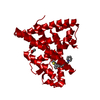 1qknS S: Starting model for refinement |
|---|---|
| Similar structure data |
- Links
Links
- Assembly
Assembly
| Deposited unit | 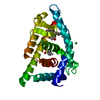
| ||||||||
|---|---|---|---|---|---|---|---|---|---|
| 1 | 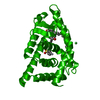
| ||||||||
| Unit cell |
| ||||||||
| Details | BIOMOLECULEHOMODIMER |
- Components
Components
| #1: Protein | Mass: 28686.002 Da / Num. of mol.: 1 / Fragment: LIGAND-BINDING DOMAIN Source method: isolated from a genetically manipulated source Details: COMPLEXED WITH THE FULL ANTAGONIST ICI164,384 / Source: (gene. exp.)   | ||
|---|---|---|---|
| #2: Chemical | ChemComp-AOE / | ||
| #3: Chemical | ChemComp-PMB / | ||
| #4: Chemical | | #5: Water | ChemComp-HOH / | |
-Experimental details
-Experiment
| Experiment | Method:  X-RAY DIFFRACTION / Number of used crystals: 1 X-RAY DIFFRACTION / Number of used crystals: 1 |
|---|
- Sample preparation
Sample preparation
| Crystal | Density Matthews: 2.22 Å3/Da / Density % sol: 44 % | ||||||||||||||||||||||||||||||||||||||||||
|---|---|---|---|---|---|---|---|---|---|---|---|---|---|---|---|---|---|---|---|---|---|---|---|---|---|---|---|---|---|---|---|---|---|---|---|---|---|---|---|---|---|---|---|
| Crystal grow | pH: 8.5 Details: 7.0% (W/V) PEG 2000 MONOMETHYL ETHER 0.0035M NICKEL CHLORIDE 0.035M TRIS-HCL, PH 8.5 | ||||||||||||||||||||||||||||||||||||||||||
| Crystal grow | *PLUS Temperature: 18 ℃ / Method: vapor diffusion, hanging drop | ||||||||||||||||||||||||||||||||||||||||||
| Components of the solutions | *PLUS
|
-Data collection
| Diffraction | Mean temperature: 100 K |
|---|---|
| Diffraction source | Source:  SYNCHROTRON / Site: SYNCHROTRON / Site:  ESRF ESRF  / Beamline: ID14-4 / Wavelength: 0.9464 / Beamline: ID14-4 / Wavelength: 0.9464 |
| Detector | Type: ADSC QUANTUM 4 / Detector: CCD / Date: Feb 23, 1999 |
| Radiation | Protocol: SINGLE WAVELENGTH / Monochromatic (M) / Laue (L): M / Scattering type: x-ray |
| Radiation wavelength | Wavelength: 0.9464 Å / Relative weight: 1 |
| Reflection | Resolution: 2.3→20 Å / Num. obs: 12201 / % possible obs: 98.2 % / Observed criterion σ(I): -3 / Redundancy: 4 % / Biso Wilson estimate: 48.5 Å2 / Rsym value: 0.06 / Net I/σ(I): 14.4 |
| Reflection shell | Resolution: 2.3→2.34 Å / Redundancy: 4 % / Mean I/σ(I) obs: 2 / Rsym value: 0.326 / % possible all: 98.6 |
| Reflection | *PLUS Lowest resolution: 20 Å / Num. measured all: 185069 / Rmerge(I) obs: 0.06 |
| Reflection shell | *PLUS % possible obs: 98.6 % / Rmerge(I) obs: 0.326 / Mean I/σ(I) obs: 2 |
- Processing
Processing
| Software |
| ||||||||||||||||||||||||||||||||||||||||||||||||||||||||||||||||||||||||||||||||||||
|---|---|---|---|---|---|---|---|---|---|---|---|---|---|---|---|---|---|---|---|---|---|---|---|---|---|---|---|---|---|---|---|---|---|---|---|---|---|---|---|---|---|---|---|---|---|---|---|---|---|---|---|---|---|---|---|---|---|---|---|---|---|---|---|---|---|---|---|---|---|---|---|---|---|---|---|---|---|---|---|---|---|---|---|---|---|
| Refinement | Method to determine structure:  MOLECULAR REPLACEMENT MOLECULAR REPLACEMENTStarting model: 1QKN Resolution: 2.3→20 Å / Cross valid method: THROUGHOUT / σ(F): 0 / ESU R: 0.31611 / ESU R Free: 0.22821 Details: BULK SOLVENT CORRECTION CALCULATED IN XPLOR V3.843 WAS USED THROUGHOUT REFINEMENT. TEMPERATURE FACTORS OF HG OF RESIDUE PMB A1437 REFINED ANISOTROPICALLY. ISOTROPIC MODEL USED FOR REMAINING ...Details: BULK SOLVENT CORRECTION CALCULATED IN XPLOR V3.843 WAS USED THROUGHOUT REFINEMENT. TEMPERATURE FACTORS OF HG OF RESIDUE PMB A1437 REFINED ANISOTROPICALLY. ISOTROPIC MODEL USED FOR REMAINING ATOMS. RESIDUES AFTER LYS435 ARE NOT VISIBLE IN THE ELECTRON DENSITY MAPS. PCMBS MOLECULE COVALENTLY BOUND (PMB) TO CYS289
| ||||||||||||||||||||||||||||||||||||||||||||||||||||||||||||||||||||||||||||||||||||
| Displacement parameters | Biso mean: 53 Å2 | ||||||||||||||||||||||||||||||||||||||||||||||||||||||||||||||||||||||||||||||||||||
| Refinement step | Cycle: LAST / Resolution: 2.3→20 Å
| ||||||||||||||||||||||||||||||||||||||||||||||||||||||||||||||||||||||||||||||||||||
| Refine LS restraints |
| ||||||||||||||||||||||||||||||||||||||||||||||||||||||||||||||||||||||||||||||||||||
| Software | *PLUS Name: REFMAC / Classification: refinement | ||||||||||||||||||||||||||||||||||||||||||||||||||||||||||||||||||||||||||||||||||||
| Refinement | *PLUS Lowest resolution: 20 Å / Rfactor obs: 0.21966 | ||||||||||||||||||||||||||||||||||||||||||||||||||||||||||||||||||||||||||||||||||||
| Solvent computation | *PLUS | ||||||||||||||||||||||||||||||||||||||||||||||||||||||||||||||||||||||||||||||||||||
| Displacement parameters | *PLUS |
 Movie
Movie Controller
Controller




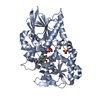
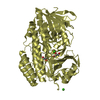

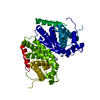

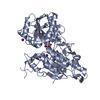
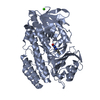
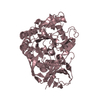
 PDBj
PDBj





